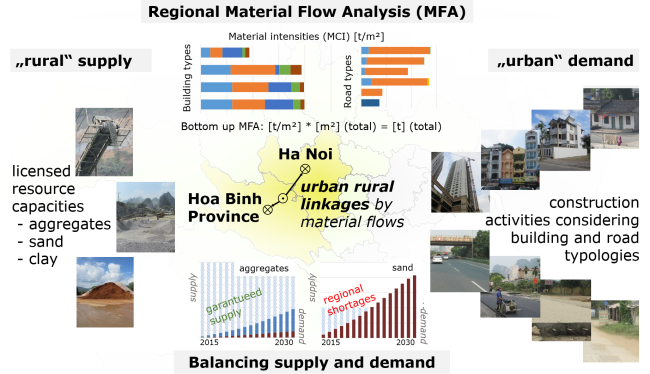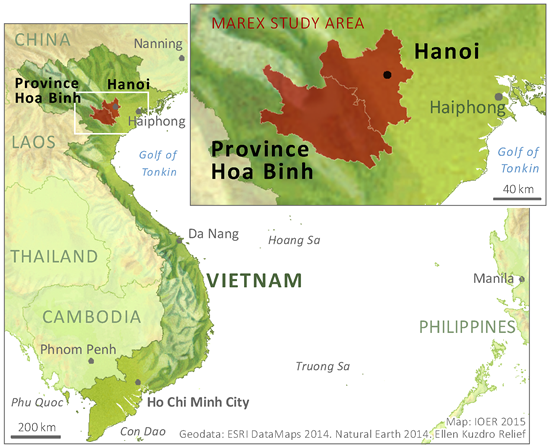MAREX
Management of Mineral Resource Extraction in Hoa Binh Province - A Contribution to Sustainable Development in Vietnam

Background
Vietnam is a fast developing country with a strong economic growth. Mining is a sector of high importance as raw material extraction provides a basis for the processing industry, for energy supply, and for the construction sector. The share of mining industry is 11 % of the Vietnamese GDP (2011). However, like many other resources rich countries, Vietnam is currently experiencing a severe threat to its natural environment due to increasing mining activities.
Urbanization is the crucial driving force for the increasing demand of building material and related activities in extraction of stones, gravel and sand. According to assumptions, the urban population in Vietnam is expected to increase from approximately 30% in 2013 to more than 50% in 2025.
Project Objectives
MAREX was a joint German-Vietnamese project in interdisciplinary applied science of spatial development. The main objective of the project is to improve the management of mineral resources in Vietnam and to contribute to Vietnam’s Sustainable Development Strategy.
The project exposes the growth of Megacities and its impacts on the environment. Scientific investigations are directed on the building industry based on local finite resources, taking into consideration all related activities like extraction and processing of raw materials, transport, building sector as well as potential recycling of construction and demolition waste. The Metropolitan region of Hanoi and Hoa Binh Province serve as a comprehensive model basis for wider application within and outside of Vietnam.
Modules
Project MAREX was subdivided into 4 topic-oriented MODULES
Module 1: Environmental monitoring of mining activities
Module 2: Cleaner Production Technologies
Module 3: Material Flow Analysis
Module 4: Management of mining and raw materials
Module 3: Material Flow Analysis
Module 3 aimed on introducing techniques and methodologies of Material Flow Analysis (MFA) of the built environment dynamic as an instrument to calculate demand and supply in the minerals mining industry in order to foster optimized planning in the context of mining an resource efficiency. The output was projected as an approach suitable to analyse
Method for Quantifying Supply and Demand of Construction Minerals in Urban Regions
As a main result of Module 3 an approach of a regional material flow analysis was developed which quantifies and compares the supply and demand of mineral building materials within an urban region. In general, the bottom-up MFA method offers a suitable approach for this purpose. However, the partly very weak data basis proves to be problematic, which hampers a robust description of the building and infrastructure stock. With suitable assumptions, backed up by the literature, it is possible to close gaps, make general trend statements possible, and achieve results that stand up to comparison with benchmarks from the literature. It is obvious from the results that scarcity of raw materials can, by nature, take very different forms with regard to different categories of materials in a specific spatial context. The identification and quantification of these interrelationships within specific regions facilitates the design of comprehensive strategies for securing raw materials. However, this also supports an extended assessment of the resource efficiency of urbanization, taking into account aspects of the availability of raw materials. It becomes clear that resource efficiency and sustainability can only be achieved if the hinterland is adequately considered. This offers new perspectives for the search for appropriate strategies of material substitution and their specification. The viewpoint taken here also emphasizes the importance of cross-sectoral planning. What is needed is a strong integration of settlement planning in urban areas with resource planning and affected land use planning in the hinterland.
Publications
Schiller, Georg., Bimesmeier, Tamara., Pham, Anh T.V. (2020): Method for Quantifying Supply and Demand of Construction Minerals in Urban Regions—A Case Study of Hanoi and Its Hinterland.
Abstract: https://www.mdpi.com/2071-1050/12/11/4358 (PDF Version: https://www.mdpi.com/2071-1050/12/11/4358/pdf)
Schneider, P., Oswald, K.-D., Riedel, W., Meyer, A., Schiller, G., Bimesmeier, T., Pham Thi, V.A., Nguyen Khac, L. (2018): Engineering Perspectives and Environmental Life Cycle Optimization to Enhance Aggregate Mining in Vietnam. Sustainability 10, 525. https://doi.org/10.3390/su10020525
Bimesmeier, Tamara; Schiller, Georg (2017): Planning-oriented Material Flow Analysis to support the management of mineral resources extraction in Vietnam, 20-28
Müller, Bernhard; Pham, Ngoc Ho; Wirth, Peter; Schiller, Georg; Vu, Anh Minh (Eds.) (2016): MAREX – Management of mineral resource extraction in Hoa Binh Province – A contribution to sustainable development in Vietnam. Conference documentation, 27.06.-01.07.2016, Dresden, 115 p.
Regional material flow analysis
A concept for balancing supply and demand of construction minerals for regions using the example of Hanoi and the hinterland province Hoa Binh
Georg Schiller, Tamara Bimesmeier
http://marex-project.de/publications/final/MAREX_Issue5_Schiller_WEB.pdf
Cleaner production, mining optimizing approaches and material flow analysis
MAREX Workshop, Hoa Binh, Vietnam, November 2017
Tamara Bimesmeier, Pham Thi Viet Anh, Klaus Dieter Oswald, Wolfgang Riedel, Georg Schiller, Petra Schneider
marex-project.de/publications/final/MAREX_Issue4_optimiert_WEB.pdf

![[Translate to English:] Bild-Schrift-Collage](/fileadmin/_processed_/7/a/csm_marex-logo_e7ff08ca84.png)

![[Translate to English:] Leibniz Gemeinschaft](/fileadmin/user_upload/ioer_de/img/logo-leibniz-gemeinschaft.svg)
![[Translate to English:] Dresden concept](/fileadmin/_processed_/2/1/csm_logo-dresden-concept_430c661ad7.png)

